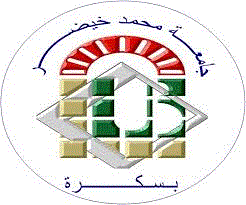| Titre : | Federated Learning for Cybersecurity: Enhancing Threat Detection Across Multiple Organizations |
| Auteurs : | Meriem Boussaha, Auteur ; Bilal Ghamri, Auteur ; Ahmed Tibermacine, Directeur de thèse |
| Type de document : | Mémoire magistere |
| Editeur : | Biskra [Algérie] : Faculté des Sciences Exactes et des Sciences de la Nature et de la Vie, Université Mohamed Khider, 2025 |
| Format : | 1 vol. (77 p.) / ill.couv.ill.encoul |
| Langues: | Anglais |
| Langues originales: | Anglais |
| Résumé : |
The rapidevolutionofdigitalecosystemshaveintensifiedcyberthreats,creatingsig- nificantchallengesfordataprivacy,regulatorycompliance,andoperationalresiliencein cybersecurity.ThisresearchintroducesaFederatedLearning(FL)frameworkforcol- laborativecybersecuritythreatdetection,aimedatenhancingtheprecision,scalability, and privacyofthreatdetectionsystems.Asadecentralizedmachinelearningparadigm, FL enablesmultipleentitiestotrainasharedpredictivemodelcollaborativelywithout exchangingsensitivedata,therebyensuringcompliancewithprivacyregulationsandmit- igatingdatabreachrisks.ThisstudyproposesanovelFLbasedapproachtailoredforcybersecurity,addressinga wide rangeofcyberthreats.Theframeworkfacilitatesdistributedtrainingacrosshetero- geneous entities,leveraginglocaldatatoimprovedetectionaccuracywhilemaintaining data sovereignty.Throughextensiveempiricalevaluationsusingreal-worldcybersecurity datasets, theproposedapproachdemonstratessuperiorperformanceindetectingthreats compared totraditionalcentralizedmethods,achievinghighaccuracyandrobustness while significantlyenhancingdataprivacyandscalability. The findingshighlightFederatedLearningasatransformativesolutionforprivacy- preserving cybersecurity,offeringascalableandsecureframeworktocounterdynamic cyberthreatsindistributedenvironments.Thisresearchlaysthegroundworkforfuture advancementsinAI-driven,ethicallycompliantcybersecuritysolutions. |
| Sommaire : |
General Introduction 13 1 IntroductionofCybersecurityChallenges 16 1.1 Introduction . .................................. 16 1.2 CoreCybersecurityConcepts . ........................ 16 1.2.1 Confidentiality,Integrity,andAvailability(CIATriad) . ...... 16 1.2.2 Threats,Vulnerabilities,andAttacks . ................ 17 1.2.3 NetworkSecurity,EndpointProtection,andAccessControl . .... 17 1.2.4 TraditionalSecurityMechanisms . .................. 18 1.3 CommonandEmergingCybersecurityThreats . ............... 19 1.3.1 CommonCybersecurityThreats . ................... 19 1.3.2 EmergingCybersecurityThreats . .................. 20 1.4 ChallengesandLimitations . ......................... 21 1.4.1 EvolvingThreatLandscape . ..................... 21 1.4.2 HumanFactor . ............................. 22 1.4.3 LackofSkilledProfessionals . ..................... 22 1.4.4 LegacySystemsandComplexity . ................... 22 1.4.5 CostandResourceLimitations . ................... 23 1.4.6 InsiderThreats . ............................ 23 1.4.7 PrivacyandComplianceChallenges . ................. 24 1.5 IntroductiontoArtificialIntelligenceinSecurity . .............. 24 1.5.1 OverviewofAI . ............................ 24 1.5.2 WhyAIfitsintocybersecurity . .................... 25 1.6 AIApplicationsinCybersecurity . ...................... 27 1.6.1 ThreatDetectionandPrevention . .................. 27 1.6.2 Behavior-BasedAnomalyDetection . ................. 27 1.6.3 AIinSecurityOperationsCenters(SOCs) . ............. 27 1.6.4 AutomatedIncidentResponseandFraudDetection . ........ 27 1.7 ProblemStatementandobjectivesoftheproject . .............. 28 1.8 Conclusion . ................................... 29 2 StateOfArt 30 2.1 RelatedworkonDistrebutedDenialofserviceAttacks . .......... 30 2.2 RelatedworkonBruteForceAttacks . .................... 31 2.3 RelatedworkonWebAttacks . ........................ 32 2.4 RelatedworkonManinTheMiddleAttacks . ................ 33 2.5 RelatedworkonDenialofServiceAttacks . ................. 34 2.6 RelatedworkonPhishingAttacks . ...................... 35 2.7 Relatedwo2.8 RelatedworkonRansomewareAttacks . ................... 36 2.9 RelatedworkonBotnetActivity . ...................... 37 2.10 RelatedworkonPortScanning . ....................... 38 3 MethodologyoftheFederatedLearningApproach 40 3.1 Introduction . .................................. 40 3.2 InvestigatedSecurityThreats . ........................ 40 3.2.1 BruteForceAttacks . ......................... 40 3.2.2 DenialofService(DoS)Attacks . ................... 41 3.2.3 WebAttacks . ............................. 41 3.2.4 InfiltrationAttacks . .......................... 42 3.2.5 PortScanning . ............................. 42 3.2.6 DistributedDenialofService(DDoS) . ................ 42 3.2.7 BotnetTraffic . ............................. 42 3.2.8 DistributedReflectionDenialofService(DRDoS)Attacks . .... 42 3.2.9 HeartbleedAttack . .......................... 42 3.3 DataPresentation . ............................... 43 3.3.1 DatasetOverview . ........................... 43 3.3.2 DataCollectionProcess . ....................... 43 3.3.3 FeatureComposition . ......................... 43 3.3.4 LabelingandDataOrganization . ................... 44 3.3.5 StatisticalOverview . ......................... 44 3.4 DataPreprocessing . .............................. 45 3.4.1 InitialDatasetImportandInspection . ................ 45 3.4.2 HandlingMissingandInfiniteValues . ................ 45 3.4.3 Non-NumericalFeatureElimination . ................. 46 3.4.4 LabelTransformationandIntegrityVerification . .......... 46 3.4.5 DimensionalConsistencyandValidation . .............. 46 3.4.6 FeatureScalingandNormalization . ................. 46 3.4.7 Train-TestStratifiedPartitioning . .................. 47 3.4.8 DataTypeConversionandFinalChecks . .............. 47 3.5 FeatureSelection . ............................... 47 3.5.1 MotivationandRationale . ...................... 47 3.5.2 AlgorithmicOverviewofSelectKBest . ................ 47 3.5.3 MutualInformationasaScoringFunction . ............. 48 3.5.4 ApplicationandOutcome . ...................... 48 3.5.5 JustificationofMethodSelection . .................. 49 3.6 FederatedLearning-BasedApproach . .................... 49 3.6.1 Introduction . .............................. 49 3.6.2 FederatedLearningProcess . ..................... 50 3.6.3 FederatedLearningArchitectures . .................. 51 3.6.4 FederatedLearningAlgorithms . ................... 53 3.6.4.1 FederatedAveraging(FedAvg) . ............... 53 3.6.4.2 FederatedProximal(FedProx) . ............... 54 3.6.4.3 OtherVariants . ....................... 54 3.6.5 ProposedModel . ............................ 55 3.6.5.1 ModelOverview . ...................... 55 3.6.5.2 ArchitecturalDesign . .................... 55 ContentsrkonInfiltrationAttacks . .................... 3.6.5.3 ModelOptimizationandStability . ............. 56 3.6.5.4 ComparativeAnalysiswithOtherNeuralModels . .... 56 3.6.5.5 WhyDRFNOutperformsSimplerModels . ........ 57 3.6.6 GlobalArchitecture . .......................... 58 3.6.7 ChallengesandSolutionsinFederatedLearning . .......... 58 3.6.8 FederatedLearninginComparisontoTraditionalMachineLearning and DistributedMachineLearning . ................. 61 3.6.8.1 TraditionalMachineLearning . ............... 61 3.6.8.2 DistributedMachineLearning . ............... 62 3.6.8.3 FederatedLearning . ..................... 62 3.6.8.4 ComparativeSummary . ................... 62 3.7 Conclusion . ................................... 63 4 ImplementationandResults 64 4.1 Introduction . .................................. 64 4.2 Environmentanddevelopmenttools . ..................... 64 4.2.1 AnacondaNavigator . ......................... 64 4.2.2 Python . ................................. 64 4.2.3 JupyterNotebook . ........................... 65 4.2.4 TensorFlow . .............................. 65 4.2.5 Flower . ................................. 65 4.3 ImplementationofFederatedLearningusingFlowerFramework . ..... 66 4.3.1 ServerDesign . ............................. 66 4.3.2 ClientConfiguration . ......................... 67 4.3.3 CommunicationFlowandSynchronization . ............. 67 4.4 Results . ..................................... 68 4.4.1 PerformanceEvaluation . ....................... 68 4.4.1.1 FedAvg . ........................... 68 4.4.1.2 FedProx . ........................... 74 4.5 Remark . .................................... 80 4.6 Conclusion . ................................... 80 General Conclusion 81 |
| Type de document : | Mémoire master |
Disponibilité (1)
| Cote | Support | Localisation | Statut |
|---|---|---|---|
| MINF/942 | Mémoire master | bibliothèque sciences exactes | Consultable |





